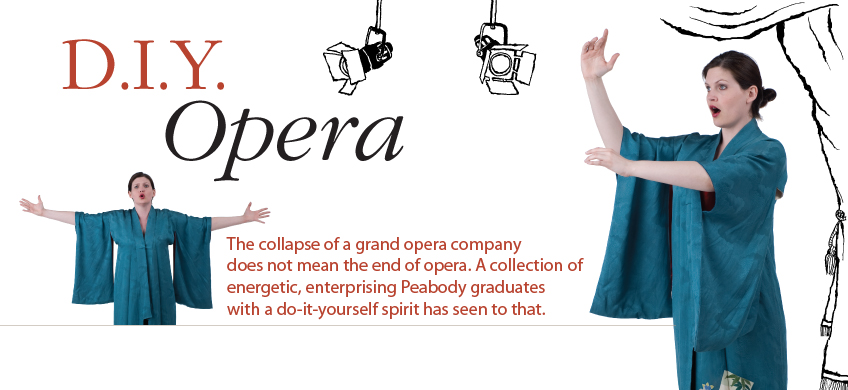
Shortly after the Baltimore Opera’s demise, the touring company Teatro Lirico D’Europa began staging grand operas at Baltimore’s Hippodrome Theatre, performing as Baltimore Opera Theatre. Meanwhile, the Lyric Opera House, where Baltimore Opera had performed, created Lyric Opera Baltimore, a new organization with James Harp as artistic director and a mandate to collaborate with companies from cities like Indianapolis and Pittsburgh to stage large-scale Baltimore productions in 2011. He says, “What we want to accomplish here is really grand opera, the whole kit and caboodle with orchestra, chorus, principals, and ballet.” The Lyric plans to open its first season with La Traviata, followed by The Marriage of Figaro, then Faust.
BALTIMORE’S NEW OPERA BABIES have been sustained in large part by young artists who have the zeal, energy, and available time of youth. All are aware that they will eventually run out of all three, at which point their companies will be on sustainable business models, or gone. “The adventure part is probably good for a few years,” says Smith. “But I don’t see how you can go on forever. Every little step is so difficult. You can’t go far without angels stepping in and writing checks.”
These little companies have none of the corporate support you will find for a major performing arts organization like the Baltimore Symphony Orchestra. Nelson, the founder of American Opera Theater, supports himself as a freelance opera director, working half the year in Europe, and supports his company almost entirely on gate receipts from performances. “We wanted part of our modus operandi to be that we do strange productions that expand the definition of what is opera,” he says. “That doesn’t fit nicely into the little packet that a corporate sponsor wants. If you want to be the opera company that does not have the cocktail reception, there’s not much left for the corporate donor.”
Says Cooke, “My marriage can’t survive another year of doing this for free.” He estimates that he spends 50 hours a week working on Baltimore Concert Opera business, on top of his day job as partner in a real estate company, on top of being the father of a toddler. As a business, his company has been savvy and alert. When the Baltimore Opera auctioned off its property, BCO bought all 45 sets of the company’s supertitles, which it now rents to other ensembles, bringing in about $3,500 last year. Baltimore Opera’s cubicles? BCO bought those too, and promptly resold them for a handsome profit. But Cooke says the company has to grow to where it can begin paying its staff.
Both Vincent and Stewart have day jobs, the former as an academic program coordinator at Peabody, the latter as a research coordinator in the School of Medicine’s Pediatric Pulmonary Division. Vincent says, “I don’t necessarily expect Figaro Project to go on for 10 or 15 years. I want it to go on for as long as I know people who love to sing and want to make music and need performance opportunities. In an ideal world, I’d like to think that it’s just twiddling our thumbs until people can afford to revitalize the arts. If that’s not the case, Figaro Project and companies like it will morph into something else. We’ll have to mature and get a board and more of a foundation. For now it’s just important to keep something alive. I have the energy, so let’s do it.”
Harp has been around opera longer than any of them, and he says, “The assurance of economic surety for artists is not great. We love what we do. We can’t live unless we do it. But we are looking at ways to reinvent ourselves to be able to have our art but also have a life and pay our bills. Nobody will be able to make big bucks from this, and that’s not bad as long as we are able to piece together a living.”
There does not seem to be a shortage of people willing to try. At least a dozen times, says Cooke, he has answered the phone to find the person on the other end calling for advice. How, exactly, does one go about establishing a new opera company?
Dale Keiger is associate editor of Johns Hopkins Magazine.
